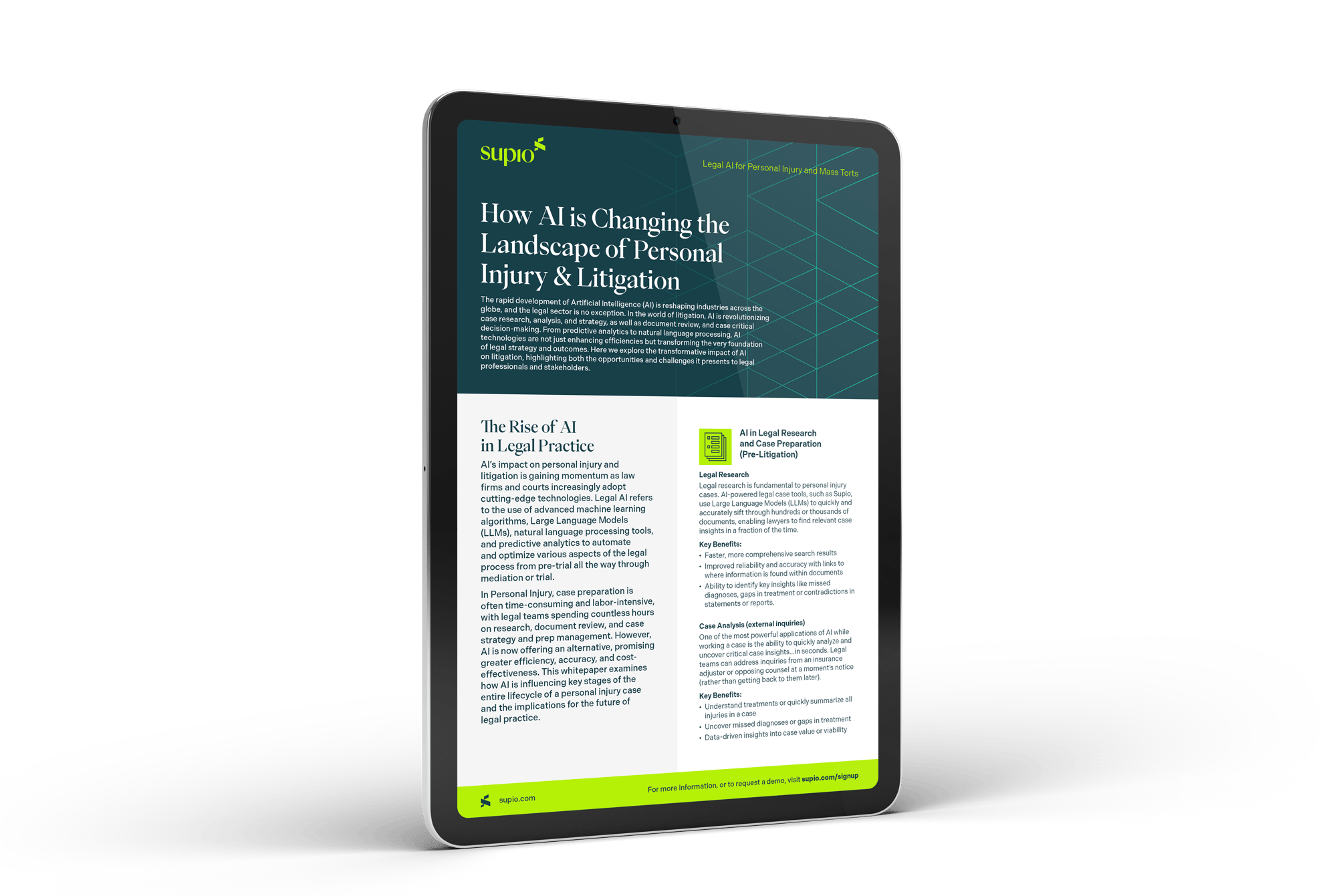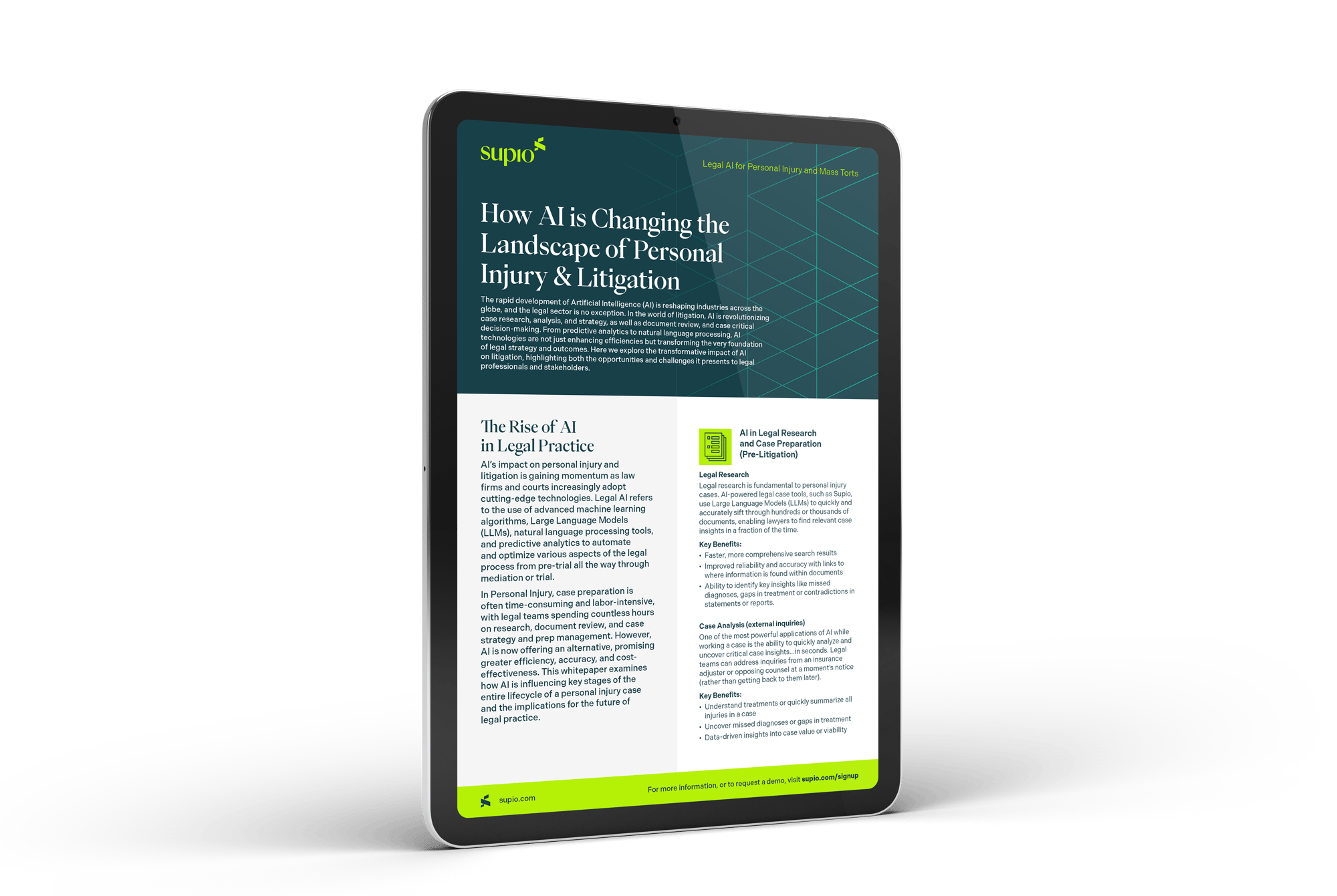
How AI Is Changing the Landscape of Personal Injury and Litigation
The rapid development of Artificial Intelligence (AI) is reshaping industries across the globe, and the legal sector is no exception. In the world of litigation, AI is revolutionizing case research, analysis, and strategy, as well as document review, and case critical decision-making. From predictive analytics to natural language processing, AI technologies are not just enhancing efficiencies but transforming the very foundation of legal strategy and outcomes.
Here we explore the transformative impact of AI on litigation, highlighting both the opportunities and challenges it presents to legal professionals and stakeholders.
Introduction: The Rise of AI in Legal Practice
AI’s impact on personal injury and litigation is gaining momentum as law firms and courts increasingly adopt cutting-edge technologies. Legal AI refers to the use of advanced machine learning algorithms, Large Language Models (LLMs), natural language processing tools, and predictive analytics to automate and optimize various aspects of the legal process from pre-trial all the way through mediation or trial.
In Personal Injury, case preparation is often time-consuming and labor-intensive, with legal teams spending countless hours on research, document review, and case strategy and prep management. However, AI is now offering an alternative, promising greater efficiency, accuracy, and cost-effectiveness. This whitepaper examines how AI is influencing key stages of the entire lifecycle of a personal injury case and the implications for the future of legal practice.
AI for Legal Research and Case Preparation
Legal Research
Legal research is fundamental to personal injury cases. AI-powered legal case tools, such as Supio, use Large Language Models (LLMs) to quickly and accurately sift through hundreds or thousands of documents, enabling lawyers to find relevant case insights in a fraction of the time.
Key Benefits:
- Faster, more comprehensive search results
- Improved reliability and accuracy with links to where information is found within documents
- Ability to identify key insights like missed diagnoses, gaps in treatment or contradictions in statements or reports.
Case Analysis
One of the most powerful applications of AI while working a case is the ability to quickly analyze and uncover critical case insights...in seconds. Legal teams can address inquiries from an insurance adjuster or opposing counsel at a moment's notice (rather than getting back to them later).
Key Benefits:
- Understand treatments or quickly summarize all injuries in a case
- Uncover missed diagnoses or gaps in treatment
- Data-driven insights into case value or viability
AI for Document Review and Courtroom Strategy
Document Review
Document review is a crucial but highly time-consuming aspect of personal injury cases, especially in large-scale cases involving vast amounts of data or documents. AI tools, through LLMs, are revolutionizing the review process by automating the identification of relevant data within these documents, offering human-like accuracy.
Key Benefits:
- Time and cost savings
- Reduction in human error
- More efficient handling of complex data sets
Courtroom Strategy & Litigation Outcomes
AI-Assisted Litigation Strategy
AI is enabling legal professionals to enhance their courtroom strategies by providing data-driven insights in real-time, with the ability to discredit opposing counsel or create line of questioning based on case documentation. AI-based tools are trained to uncover deposition or expert report contradictions or analyze arguments and briefs to predict which legal points are likely to succeed in front of specific judges or juries.
Key Benefits:
- Informed strategy development
- Enhanced ability to anticipate the opposing counsel’s arguments
- Real-time insights during trials
Key Considerations and Future Developments
Ethical and Legal Implications of AI in Personal Injury Cases
As AI becomes more embedded in personal injury cases, ethical concerns are emerging. Key issues include the transparency of AI algorithms, the potential for bias, and the question of accountability. AI's capacity to influence legal decision-making also raises questions about the traditional role of the attorney and the judge.
Key Ethical Considerations:
- Finding AI solutions with HIPAA compliance and security measures in place to protect data
- Find AI solutions that eliminate risk with hallucinations by offering links to where your information is being pulled from
The Future of AI in Personal Injury
As AI continues to evolve, its role in personal injury will expand beyond research and document review. The integration of AI in litigation will require new frameworks for legal education, training, and ethics. The future of litigation will be a blend of human expertise and machine intelligence, with AI serving as a powerful tool in the hands of skilled legal professionals.
Future AI developments are likely to include:
- Enhanced AI-driven legal strategy tools capable of providing more nuanced insights and historical comparisons.
- AI judges in routine cases, potentially transforming lower courts.
- Blockchain integration to ensure the authenticity of legal documents and evidence.
Conclusion
AI is undeniably changing the landscape of personal injury cases and litigation. Its ability to streamline processes, enhance case research and analysis, and assist in decision-making and strategy is transforming how cases are managed and won. In order to remain competitive, legal professionals must adapt to this new era, ensuring that they harness AI's capabilities while remaining mindful of the limitations and responsibilities that come with its use. The future of personal injury and litigation is bright and lucrative for law firms.

